

However, before that, let's understand what self-identity is. Sense of Self: What It Is and How to Build It. Your sense of self refers to your perception of the collection of characteristics that define you.

Personality traits, abilities, likes and dislikes, your belief system or moral code, and the things that motivate you — these all contribute to self-image or your unique identity as a person. People who can easily describe these aspects of their identity typically have a fairly strong sense of who they are. What Is Self-Concept and How Does It Form? Self-concept is the image that we have of ourselves.
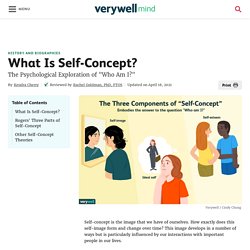
How exactly does this self-image form and change over time? This image develops in a number of ways but is particularly influenced by our interactions with important people in our lives. What Is Self-Concept? Self-concept is how you perceive your behavior, abilities, and unique characteristics.1 For example, beliefs such as "I am a good friend" or "I am a kind person" are part of an overall self-concept. Self-concept tends to be more malleable when you're younger and still going through the process of self-discovery and identity formation. Erik Erikson's Stages of Psychosocial Development. Erik Erikson was an ego psychologist who developed one of the most popular and influential theories of development.
While his theory was impacted by psychoanalyst Sigmund Freud's work, Erikson's theory centered on psychosocial development rather than psychosexual development. The stages that make up his theory are as follows:1. Erik Erikson and Self-Identity - Child Development Theory: Adolescence (12-24) According to Erik Erikson, a prominent developmental theorist of the 1950's, youth must resolve two life "crises" during adolescence.
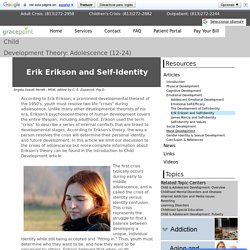
Unlike many other developmental theorists of his era, Erikson's psychosocial theory of human development covers the entire lifespan, including adulthood. Erikson used the term "crisis" to describe a series of internal conflicts that are linked to developmental stages. According to Erikson's theory, the way a person resolves the crisis will determine their personal identity and future development. Lifespan Development. Learning Outcomes Describe changes in self-concept and identity development during adolescenceExplain Marcia’s four identity statuses Psychosocial Development.
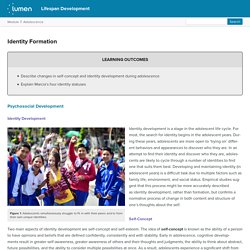
Adolescent Development - The Promise of Adolescence - NCBI Bookshelf. Eriksons Stages of Psychosocial Development - StatPearls - NCBI Bookshelf. 7.3 Adolescence: Developing Independence and Identity – Introduction to Psychology – 1st Canadian Edition. Learning Objectives Summarize the physical and cognitive changes that occur for boys and girls during adolescence.Explain how adolescents develop a sense of morality and of self-identity.

Adolescence is defined as the years between the onset of puberty and the beginning of adulthood. In the past, when people were likely to marry in their early 20s or younger, this period might have lasted only 10 years or less — starting roughly between ages 12 and 13 and ending by age 20, at which time the child got a job or went to work on the family farm, married, and started his or her own family. Today, children mature more slowly, move away from home at later ages, and maintain ties with their parents longer. Why Is Teen Identity Development Important? Though it can be hard for parents to let go and acknowledge their teen needs external help, a credible adventure therapy program can relatively quickly and positively change your son or daughter’s life for the better.
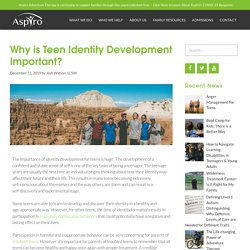
Psychologist Erik Erikson advocated that teen identity development is fostered by experiences that allow individuals to express their individuality and receive feedback and validation from others. Adventure therapy programs provide experiences that promote healthier relationships and positive identity formation in teens. Teenage Self-Identity Issues: Causes, Problems, And Common Behaviors. While there are a variety of ways that teens experience identity formation, some experiences can become very harmful to the individual.

In the sections below, we discuss the causes and more serious issues in teenage identity issues & development and how parents can help. Common Causes Contributing to Unhealthy Teen Identity Development The importance of identity development for teens is huge. The Importance of Identity Development, Principled Moral Reasoning, and Empathy as Predictors of Openness to Diversity in Emerging Adults. There are many paths to enlightenment.

—Lao Tzu, Chinese Taoist philosopher (600-531 BC) Long-studied in social psychology, the dangers of prejudice (Allport, 1954) and the importance of developing tolerance and respect for others have received attention with an increased sense of urgency over the past decade. Globally, although distances are ever-shrinking and differing cultures must cooperate for survival, terrorist threats and genocidal wars are part of the daily news.
Within the United States, although population projections suggest that racial and ethnic minorities will comprise one third of all Americans by 2015 (Wang et al., 2003) and almost half the population by the year 2030 (Cortes, 1991), conflicts among racial and ethnic groups are responsible for many hate crimes (Wang et al., 2003). Numerous institutions, from governmental agencies to educational systems, have noted the need for increasing tolerance. Six Ways to Build Your Teen's Identity - Focus on the Family. Marriages and families are in trouble after the challenges of last year.

If it's not too much to ask, would you help equip these families with the resources they need to put Jesus at the center of their home? Yes, I will help struggling families! Español. Adolescent Identity Development: What to Expect in Teens. Adolescent Identity Development: The Factors of Change Among the profound and exciting changes taking place in adolescence is the process of self-discovery. Our teens are working to figure out who they are, making adolescent identity development a central feature of teen life. Young people’s identities are shaped by lots of factors — family, cultural and societal expectations, experiences with institutions like school and the media, and friends. Young people also take active steps and make choices that shape their identity.
Identity, perception of parent-adolescent relation and adjustment in a group of university students. Family experience in facilitating adolescents during self-identity development in ex-localization in Indonesia. Identity achievement of adolescents living in ex-localization is similar to that of adolescents in general In this study, the families expressed that the identity achievements of their children in terms of changes were similar to the achievements of adolescents in general.
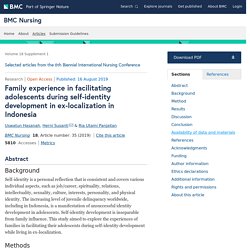
These changes included physical, appearance, and behavioral changes, the ability to build relationships with members of the opposite sex, and the ability to choose activities based on their own interests. Brownlee [14] states that development in early adolescence is characterized by rapid physical changes including height, maturity of reproductive organs, secondary sex characteristics, increased muscle strength, and weight [15, 16]. Relationships With Parents, Identity Styles, and Positive Youth Development During the Transition From Adolescence to Emerging Adulthood.